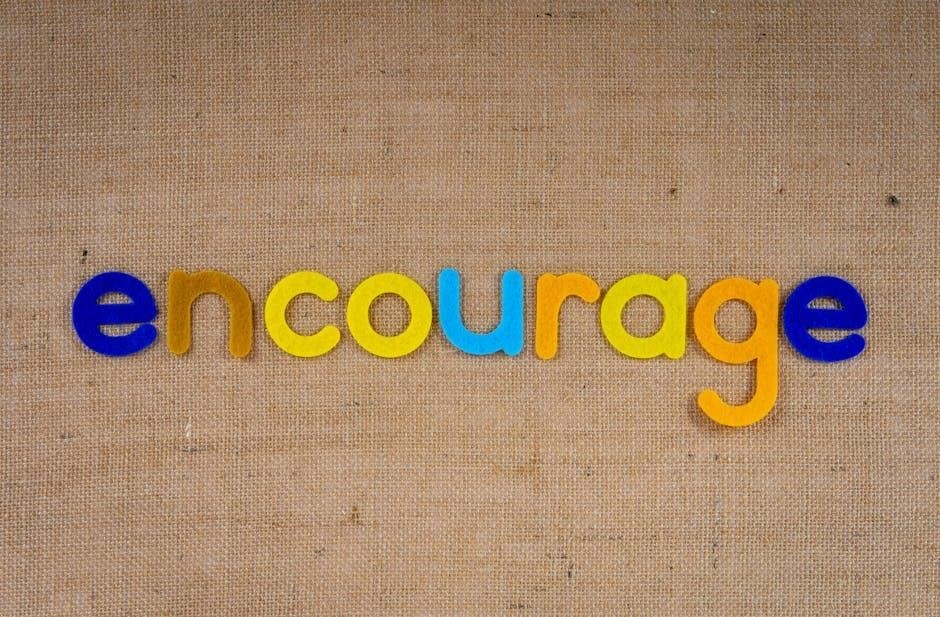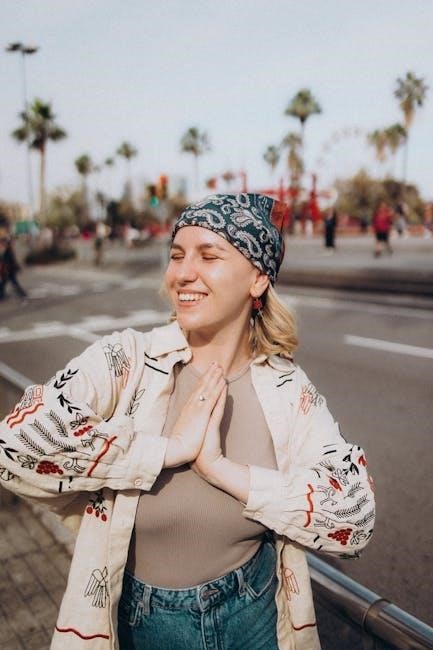Embroidery positioning is crucial for achieving professional results. Proper placement ensures designs are visually appealing and aligned correctly. Essential tools like hoops and stabilizers help maintain accuracy. Learning precise measurement techniques and avoiding common mistakes will elevate your embroidery projects to polished, professional-looking designs.
Overview of Embroidery Placement Importance
Proper embroidery placement enhances the aesthetic appeal and balance of a design. It ensures symmetry and alignment, making the embroidery stand out as intended. Incorrect positioning can distort the design or make it less visible, especially on curved or stretchy fabrics. Accurate placement is vital for professional results, as it reflects attention to detail and craftsmanship. For commercial embroidery, correct positioning also matters for brand recognition, ensuring logos or text are legible and centered. Understanding the importance of placement helps embroiderers avoid common mistakes and achieve flawless, visually appealing designs that meet client expectations and elevate the finished product’s quality.

Understanding the Basics of Embroidery Placement
Embroidery placement involves aligning designs accurately on fabric, considering size, symmetry, and garment type. Proper tools and techniques ensure precise positioning for professional-looking results every time.
Key Factors Influencing Embroidery Positioning
Accurate embroidery positioning depends on garment type, fabric stability, and design size. Fabric stretch, thickness, and texture require specific stabilizers for precise alignment. Design size and shape must complement the garment, ensuring symmetry and balance. Placement locations, like the left chest on shirts or the back of jackets, are standardized for visual appeal. Proper alignment tools, such as adhesive rulers and hoops, help maintain accuracy. Understanding these factors ensures designs are visually appealing and professionally placed, enhancing the overall embroidery outcome. Attention to these details guarantees flawless results, making embroidery positioning a foundational skill for success in embroidery projects.
How to Measure and Align Designs Accurately
Measuring and aligning embroidery designs accurately starts with identifying the garment’s key points, such as seams or buttons. Use a ruler or measuring tape to mark the center point and desired placement area. For symmetry, fold the garment to find the midpoint. Adhesive rulers or stabilizing grids can help maintain alignment. Ensure the hoop is tightly secured to prevent fabric shifting. Double-check the design’s dimensions against the target area to avoid resizing errors. Using a placement guide or stencil can provide a clear outline for precise alignment. Always test the needle position on a scrap fabric before embroidering to confirm accuracy and avoid mistakes.
Essential Tools for Precise Embroidery Placement
Key tools for embroidery placement include embroidery hoops, stabilizing materials like cutaway backing, adhesive rulers, and marking tools. These ensure accurate design alignment and fabric stability during stitching.
Role of Embroidery Hoops in Positioning
Embroidery hoops play a vital role in maintaining fabric tension, ensuring accurate needle alignment. They keep fabric taut, preventing distortion and allowing precise stitching. Hoops come in various sizes to accommodate different projects, from small designs to large-scale embroideries. The hoop’s inner ring acts as a guide, helping to center designs and align them with the needle’s path. Proper hoop usage ensures that the needle pierces the fabric consistently, making it easier to achieve professional-looking results. Additionally, hoops allow for easy repositioning, enabling embroiderers to work seamlessly across the fabric without compromising design accuracy or fabric stability.

Stabilizing Fabric for Optimal Results
Stabilizing fabric is essential for achieving precise embroidery placement. Loose weaves, knits, and stretchy materials require additional support to prevent distortion. Cutaway backing is ideal for light cotton knits, while tear-away backing works well for tighter weaves. Applying stabilizers ensures the fabric remains taut, allowing the needle to pierce evenly. Proper stabilization prevents misalignment and puckering, ensuring crisp, professional-looking stitches. For especially stretchy fabrics, using a combination of stabilizers or adhesive-backed options can provide extra support. This step is crucial for maintaining design integrity and achieving flawless embroidery results, especially on challenging materials.
Using Adhesive Rulers and Marking Tools
Adhesive rulers and marking tools are invaluable for precise embroidery placement. These tools help align designs accurately, especially on stretchy or curved fabrics. Adhesive rulers can be placed directly on the garment to mark straight lines or boundaries, ensuring symmetry and proper positioning. Marking tools, such as chalk pens or iron-on templates, create temporary guides for embroidery. They are particularly useful for outlining design areas or aligning patterns on complex shapes like pockets or cuffs. By using these tools, embroiderers can achieve professional-looking results with consistent accuracy, making the embroidery process faster and more efficient.
Positioning Embroidery on Specific Garments
Proper embroidery placement varies by garment type, ensuring designs align with style and functionality. Shirts, jackets, caps, and pockets each have specific guidelines for size, symmetry, and visibility to achieve a polished look.
Shirts: Left Chest and Center Placements
For shirts, embroidery is commonly placed on the left chest or center. The left chest placement typically positions the design 7-9 inches down from the shoulder seam, centered between the placket and side seam. This creates a balanced, professional look. Center placements are ideal for logos or larger designs, ensuring symmetry and visibility. The top of the design should be 3.5 to 4.5 inches below the neckline, centered between the left and right seams. Proper alignment ensures the embroidery stands out and complements the garment’s style, making it essential for both casual and formal wear.
Jackets: Back and Sleeve Embroidery Placement
For jackets, embroidery placement varies depending on the design and desired impact. On the back, center the design 5-6 inches below the collar for symmetry. Ensure the design aligns with the jacket’s seams for a polished look. For sleeves, place smaller designs 4-5 inches below the shoulder seam, centered vertically. Larger designs should curve slightly to follow the sleeve’s shape. Proper alignment ensures the embroidery complements the jacket’s structure and enhances its aesthetic appeal, making it suitable for both casual and formal wear.
Caps: Design Placement and Curvature
When embroidering on caps, proper placement and curvature are essential for a professional finish. Designs on the front should be centered and aligned with the cap’s seam, typically 2.5 inches tall and 4.5 inches wide. For the back, curve the design slightly to match the cap’s natural shape. Use adhesive rulers to ensure symmetry and alignment. The size of the cap frame determines the maximum design dimensions. Ensure text remains readable and adjust for curvature, especially on larger logos. Proper placement enhances the design’s visibility and appeal, making it suitable for both casual and promotional use.
Pockets: Aligning Designs for Symmetry
Pockets require precise alignment to ensure symmetry and a polished look. Designs should be centered horizontally and placed 2-3 inches below the top seam for optimal visibility; Use a ruler or measuring tape to mark the center point, ensuring the design aligns with the pocket’s edges. For larger pockets, consider the design’s proportions relative to the fabric. Stabilizing the material with cutaway backing prevents distortion. Double-check the placement before stitching to ensure symmetry and balance, especially for text or intricate patterns. Proper alignment enhances the overall aesthetic, making the embroidery stand out seamlessly on the garment.

Step-by-Step Guide to Embroidery Placement
Master embroidery placement with a systematic approach: prepare garments, use placement guides, align designs, and double-check positioning before stitching for flawless, professional-looking results every time.
Preparing the Garment for Embroidery
Properly preparing the garment is essential for accurate embroidery placement. Begin by washing and drying the fabric to remove any finishes that might affect stitching. Iron the garment to eliminate wrinkles, ensuring a smooth surface for embroidery. For stretchy materials, use stabilizers like cutaway backing to maintain stability. Position the garment in an embroidery hoop, ensuring it is taut but not overly tight. This step ensures the fabric remains steady, allowing the needle to pierce accurately. Correct preparation prevents misalignment and ensures the design adheres smoothly, resulting in professional-looking embroidery. Always test stabilizers on scraps before applying them to the final piece.
Using Placement Guides and Stencils
Placement guides and stencils are invaluable tools for achieving precise embroidery positioning. Many embroidery designs include a placement guide as the first color, often a running stitch outline indicating where the main design should go. Use these guides to align your work accurately. Stencils can also be used to mark placement points on the fabric, ensuring symmetry and proper alignment. Adhesive rulers or straightedges are helpful for drawing straight lines or marking centers. For curved areas, like sleeves or collars, curved guides can assist in maintaining even spacing. Always double-check the placement against the guide before stitching to avoid misalignment. This ensures professional-looking results every time.
Aligning the Design with the Fabric
Aligning the design with the fabric is a critical step in embroidery positioning. Start by identifying the center point of the garment and the design. Use a ruler or measuring tape to mark the center point on the fabric, ensuring it matches the design’s center. For symmetrical designs, measure evenly from side seams or plackets. Adhesive rulers or straightedges can help draw precise lines. For curved areas like sleeves or collars, use a curved guide to maintain even spacing. Always double-check the alignment by placing the design over the marked center point before stitching. This ensures the embroidery looks balanced and professional.
Double-Checking the Position Before Stitching
Double-checking the position before stitching is essential to avoid costly mistakes. Once the design is aligned, visually inspect the placement to ensure it matches the intended area. Use a ruler or measuring tape to verify the distance from seams or edges. For machine embroidery, run a simulation to see how the design will stitch out. For hand embroidery, thread the needle and gently pierce the fabric to test alignment. Make any necessary adjustments to the hoop or fabric placement before starting. This step ensures the embroidery will be accurate and professional-looking, saving time and materials in the long run.

Common Mistakes to Avoid in Embroidery Placement
Avoiding common mistakes is key to achieving flawless embroidery. One frequent error is improper hoop alignment, leading to designs being off-center. Neglecting to stabilize stretchy fabrics can result in distorted stitching. Forgetting to account for seam allowances often causes designs to be too close to edges. Incorrectly sizing designs for the garment is another oversight, making embroidery look disproportionate. Additionally, not double-checking the placement before stitching can lead to irreversible errors. Using the wrong tools, like improper rulers or inadequate stabilizers, further increases the risk of misalignment. Being mindful of these pitfalls ensures professional-looking results and saves time spent on corrections.
Mastering embroidery positioning transforms ordinary designs into professional-looking creations. By understanding placement basics, using proper tools, and avoiding common mistakes, embroiderers can achieve precise alignment. Consistent practice and attention to detail refine skills, ensuring designs are perfectly centered and proportionate. Whether embroidering on shirts, jackets, or caps, accurate placement elevates the final product. With patience and the right techniques, embroiderers can confidently create stunning, polished designs that stand out, making every stitch count towards a professional finish.
